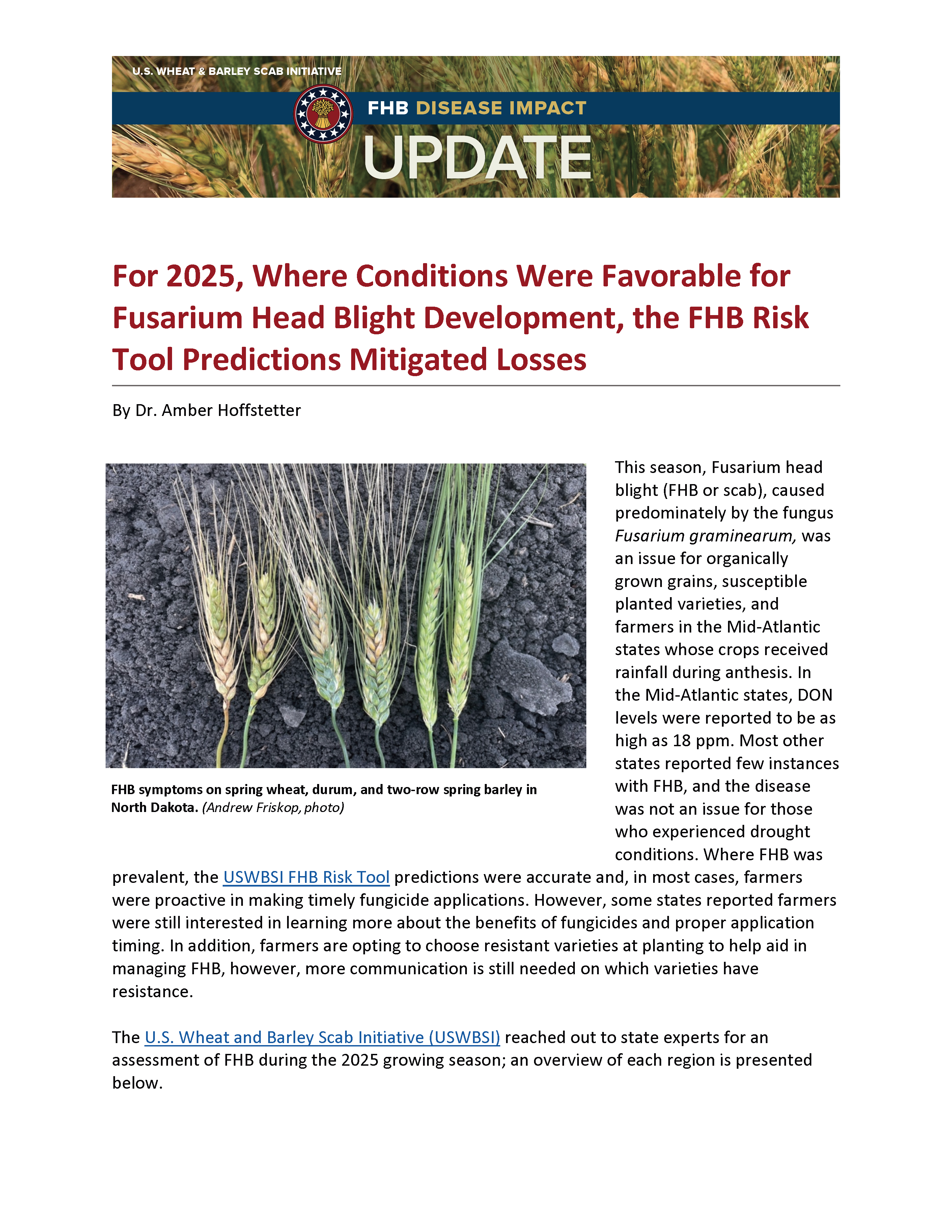FHB Disease Impact Updates

For 2025, Where Conditions Were Favorable for Fusarium Head Blight Development, the FHB Risk Tool Predictions Mitigated Losses
 The U.S. Wheat and Barley Scab Initiative (USWBSI) is pleased to announce the publishing of its 2025 Fusarium Head Blight Disease Impact Update. This year, commentary from 30 state specialists indicated where conditions where favorable for Fusarium head blight (FHB, also known as scab) development, demonstrating that the FHB Risk Tool provided accurate predictions and enabled those utilizing the tool to make appropriate management decisions. FHB was the most problematic for organically grown grains, susceptible varieties, and in the Mid-Atlantic states which received rainfall during anthesis. Reports were received from Pennsylvania and Virginia of levels of the Fusarium-associated mycotoxin deoxynivalenol (DON) exceeding 10 ppm and as high as 18 ppm in some cases. The remainder of the U.S. growing small grains mostly reported few to no issues with FHB either due to environmental conditions being dry and/or unfavorable for the fungus or where the use of integrated management strategies controlled FHB effectively.
The U.S. Wheat and Barley Scab Initiative (USWBSI) is pleased to announce the publishing of its 2025 Fusarium Head Blight Disease Impact Update. This year, commentary from 30 state specialists indicated where conditions where favorable for Fusarium head blight (FHB, also known as scab) development, demonstrating that the FHB Risk Tool provided accurate predictions and enabled those utilizing the tool to make appropriate management decisions. FHB was the most problematic for organically grown grains, susceptible varieties, and in the Mid-Atlantic states which received rainfall during anthesis. Reports were received from Pennsylvania and Virginia of levels of the Fusarium-associated mycotoxin deoxynivalenol (DON) exceeding 10 ppm and as high as 18 ppm in some cases. The remainder of the U.S. growing small grains mostly reported few to no issues with FHB either due to environmental conditions being dry and/or unfavorable for the fungus or where the use of integrated management strategies controlled FHB effectively.Read the full article...
Archived FHB Disease Summaries
Fusarium Head Blight in 2024: Fusarium Head Blight and Associated Mycotoxins Problematic in 2024, Predominately in Northern and Eastern Climates
Fusarium Head Blight in 2023: U.S. Encounters Low Levels, Impacted Crops Found in Regions Where FHB is Generally Not a Concern
Fusarium Head Blight in 2022: Conditions and Proactive Growers Reduce FHB Impact Across the U.S.
Fusarium Head Blight in 2021: Drought Conditions Minimize Impact
Fusarium Head Blight in 2020: Minimal to Modest Impact in Most States
Fusarium Head Blight in 2019: Serious Impact in Several States; Minimal to Moderate in Others
Fusarium Head Blight in 2018: Serious in Some States; Low Impact in Majority
Fusarium Head Blight in 2017: Generally, Not a Significant Impact
Fusarium Head Blight in 2016: Scab's Impact Low in Majority of U.S. Wheat & Barley Areas
Fusarium Head Blight in 2015: A Vexing Year, Overall
Fusarium Head Blight in 2014: From Nonexistent to Severe
Fusarium Head Blight in 2013: From Benign to Serious
Fusarium Head Blight in 2012: A Minimal Issue
Fusarium Head Blight in 2011: An Overview
Fusarium Head Blight in 2010: An Overview
